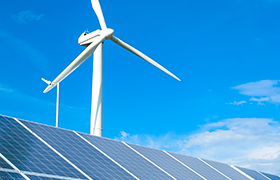

Advanced materials

Big Data and artificial intelligence (AI) require increasing computing performance and storage capacity, which is extremely energy-intensive: computers, data centers, and networks account for nearly 10 percent of the world’s electricity consumption. Quantum computing could increase computing power while reducing energy use by a factor of 100 to 1,000.
A key concern in many fields (e.g., aeronautics, transportation, security, energy, communication) is the rapid development of advanced materials, integrating design and synthesis, with pre-determined characteristics and functionalities.
| SOLEIL II's Contribution |
- Materials engineering
Monitor the phases of material synthesis and fully assess their properties under actual usage conditions.Combine high-throughput experiments with AI methods in order to accelerate material development and reduce costs.
- Information technologies
Develop new quantum materials and control their properties on demand, even when their composition is heterogeneous down to the nanometer scale (one billionth of a meter).
|
Energy and sustainable development

Computers, smartphones, tablets, electric vehicles: omnipresent in our daily lives, they operate thanks to electrochemical energy storage in batteries that we wish were more compact, safer, faster to recharge, longer-lasting, more durable, and more environmentally friendly...
In industry, 90% of reactions are catalytic and often use scarce resources (noble metals, rare earth elements, etc.). The development of new catalysts and the optimization of reactions could, by 2050, make it possible to reduce global energy consumption by an amount equivalent to Germany's current annual energy consumption.
| SOLEIL II's Contribution |
- Batteries
Develop new materials for electrodes and electrolytes using abundant chemical elements (e.g., Na, Mg, Fe), solid electrolyte technology; optimize recycling processes.
- Towards carbon-free energy
Develop fuels from sustainable resources, like biomass, to reduce greenhouse gas emissions; develop cleaner and more efficient combustion processes for existing fuel stocks; optimise solar energy conversion.
|
Health

Emerging infectious diseases are caused by pathogens (bacteria, viruses, fungi, parasites, prions) of diverse origins. The treatment of these diseases, which are becoming increasingly numerous and whose impact is amplified by ecosystem changes linked to human activity, presents a major challenge.
The structural and cellular biology techniques developed through SOLEIL II will enable the identification of targets for new therapies and provide a rapid and tailored response to these diseases (vaccines, antibiotics).
| SOLEIL II's Contribution |
- Cancer
Contribute to developing cancer treatments through a better understanding of the mechanisms of cell dysfunction leading to cancer, as well as the modes of action of novel drugs.
- New pathogens
React quickly, especially to emerging viruses (e.g., Ebola, H1N1, SARS-CoV-2) by reducing the time needed to develop new diagnostic methods, drugs, and vaccines.
|
Environment

By 2030, 50 million tons of plastic could enter aquatic ecosystems. Their degradation leads to the formation of micro- and then nano-plastic particles, which are extremely difficult to detect.
More generally, the transfer of pollutants is expected to increase with the rising frequency and intensity of extreme weather events (storms, floods) linked to climate change. Aerosols from natural sources (volcanoes, massive wildfires) and those resulting from human activity (pollution) have a significant impact on the climate.
| SOLEIL II's Contribution |
- Impact of pollutants
Understand the capacity of nanoplastics to carry contaminants from continents to oceans to assess their toxicological impact on ecosystems.
- Climate warming
Characterize in the atmosphere the interaction and transformation processes of gases and nanoparticles, whether natural or linked to human activity, in order to refine models and more accurately predict the consequences of a warming climate.
|






